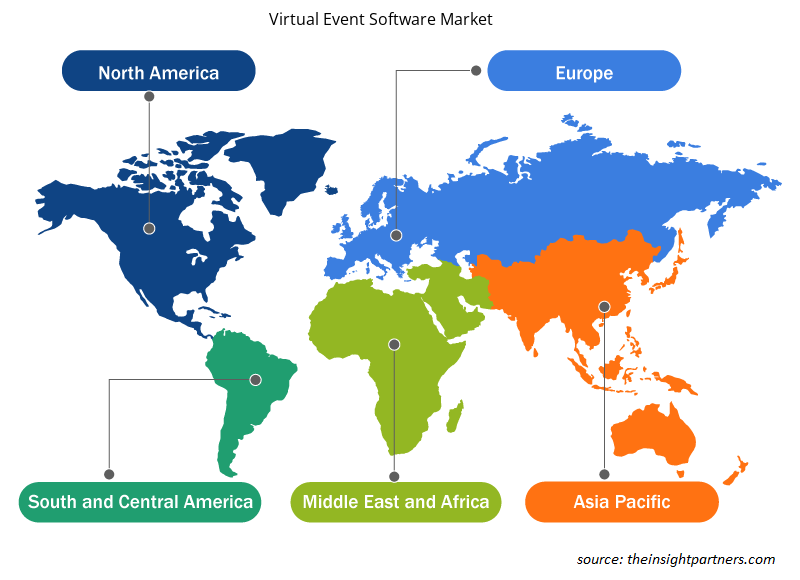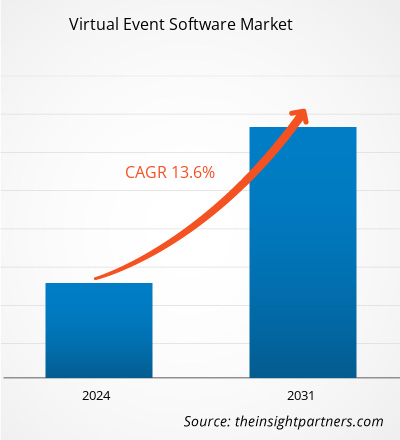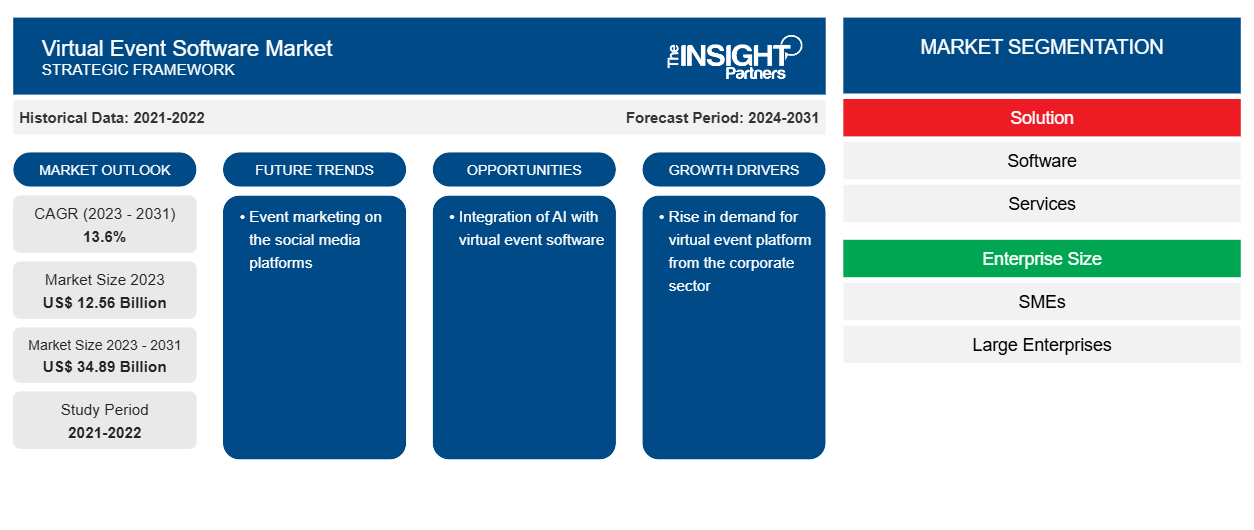Si prevede che la dimensione del mercato del software per eventi virtuali raggiungerà i 34,89 miliardi di dollari entro il 2031, rispetto ai 12,56 miliardi di dollari del 2023. Si prevede che il mercato registrerà un CAGR del 13,6% nel periodo 2023-2031. La crescita degli eventi virtuali e l'aumento dell'adozione di piattaforme per eventi virtuali basate sull'intelligenza artificiale rimarranno probabilmente tendenze chiave nel mercato.
Analisi di mercato del software per eventi virtuali
Il software per eventi virtuali sta guadagnando terreno grazie a fattori quali la crescente penetrazione di Internet, l'aumento della digitalizzazione e un aumento della cultura del lavoro da casa nel settore aziendale. La capacità del software per eventi virtuali di coinvolgere i partecipanti con varie funzionalità coinvolgenti come l'interazione one-to-one, sondaggi Q&A, chat in tempo reale, emoticon e altro ancora ne guida la domanda tra diversi utenti finali come aziende, società di gestione di eventi, organizzatori di fiere, istituzioni accademiche e altri.
Panoramica del mercato del software per eventi virtuali
Il software per eventi virtuali aiuta a condurre eventi virtualmente in modo efficiente. Presenta le stesse funzionalità del software di gestione eventi. L'unica differenza è che il software di gestione eventi include anche la gestione dell'evento di persona. Il software per eventi virtuali ha funzionalità come l'in-webcasting e si integra perfettamente con il software per webinar. Può integrare contenuti interattivi come chat di gruppo, sondaggi Q&A e networking 1:1 . L'utente può anche partecipare all'evento da qualsiasi dispositivo.
Personalizza questo report in base alle tue esigenze
Riceverai la personalizzazione gratuita di qualsiasi report, comprese parti di questo report, o analisi a livello nazionale, pacchetto dati Excel, oltre a usufruire di grandi offerte e sconti per start-up e università
-
Scopri le principali tendenze di mercato in questo rapporto.Questo campione GRATUITO includerà analisi di dati che spaziano dalle tendenze di mercato alle stime e alle previsioni.
Driver e opportunità del mercato del software per eventi virtuali
Aumento della domanda di piattaforme per eventi virtuali da parte del settore aziendale per favorire il mercato
Il settore aziendale sta sperimentando la crescente popolarità degli incontri virtuali, che è uno dei fattori chiave che guidano la necessità di una piattaforma per eventi virtuali. L'ondata di trasformazione digitale, la pandemia di COVID-19 e la cultura del lavoro da casa nel settore aziendale hanno generato la necessità di una soluzione per coinvolgere i dipendenti e gli stakeholder dell'azienda su un'unica piattaforma integrata. Le grandi aziende hanno i loro dipendenti in tutto il mondo. Per le attività di team bonding, l'azienda organizza vari eventi in cui i propri dipendenti possono impegnarsi. L'evento di team bonding aiuta le aziende a creare un team altamente performante e a sviluppare uno spazio per i dipendenti in cui possono interagire e conoscere meglio i diversi background ed esperienze reciproci. Pertanto, le aziende organizzano eventi per creare un ambiente di lavoro sano e relazioni con i dipendenti, il che alimenta ulteriormente la loro produttività sul lavoro.corporates create a high-performing team and develop space for employees where they can interact and know more about each other's diverse backgrounds and experiences. Thus, corporates organize events to create a healthy work environment and relationships with the employees, which further fuels their productivity in work.
Integrazione dell'intelligenza artificiale con il software per eventi virtuali
Le tecnologie integrate di tecnologia AI aiutano l'utente a rilevare modelli e approfondimenti per scoprire lacune e opportunità che migliorano le funzionalità di qualsiasi software e processo. Il software per eventi virtuali integrato con AI può aiutare a creare automaticamente le agende degli eventi e la pianificazione automatica degli eventi. Può personalizzare sedi e stand virtuali. Aiuta anche a replicare l'esperienza di persona sulle piattaforme virtuali. Alcuni operatori di mercato forniscono piattaforme per eventi virtuali basate su AI. Ad esempio, EventsX è una piattaforma basata su AI per organizzare, commercializzare e ospitare l'evento virtuale, ibrido o di persona perfetto. Fornisce analisi in tempo reale e post-evento che aiutano gli utenti a comprendere le esperienze del cliente. L'analisi dell'evento li aiuta anche a migliorare se stessi per un evento futuro migliorando le esperienze personalizzate del cliente.
Analisi della segmentazione del rapporto di mercato del software per eventi virtuali
I segmenti chiave che hanno contribuito alla derivazione dell'analisi di mercato del software per eventi virtuali sono la soluzione, le dimensioni dell'azienda e l'utente finale.
- In base alla soluzione, il mercato del software per eventi virtuali è suddiviso in software e servizi. Il segmento software ha detenuto la quota maggiore del mercato nel 2023.
- In base alle dimensioni aziendali, il mercato è segmentato in PMI e grandi imprese. Si prevede che le PMI cresceranno con il CAGR più elevato durante il periodo di previsione.
- In termini di utente finale, il mercato è segmentato in organizzatori di fiere, agenzie di gestione eventi, aziende, organizzazioni accademiche e altri. Si prevede che il segmento aziendale crescerà con un CAGR significativo.
Analisi della quota di mercato del software per eventi virtuali per area geografica
L'ambito geografico del rapporto sul mercato del software per eventi virtuali è suddiviso principalmente in cinque regioni: Nord America, Asia Pacifico, Europa, Medio Oriente e Africa, Sud e Centro America.
Si prevede che la regione Asia-Pacifico crescerà con il CAGR più elevato durante il periodo di previsione. La crescente digitalizzazione, la crescita nel settore aziendale e la proliferazione di Internet nella regione sono alcuni dei fattori che alimentano il mercato del software per eventi virtuali dell'Asia-Pacifico. Diverse aziende di software stanno espandendo la loro presenza e attività nella regione, il che spinge ulteriormente il mercato. L'attenzione del governo nel promuovere la digitalizzazione nella regione ha ulteriormente completato la crescita del mercato.
Approfondimenti regionali sul mercato del software per eventi virtuali
Le tendenze regionali e i fattori che influenzano il mercato del software per eventi virtuali durante il periodo di previsione sono stati ampiamente spiegati dagli analisti di Insight Partners. Questa sezione discute anche i segmenti e la geografia del mercato del software per eventi virtuali in Nord America, Europa, Asia Pacifico, Medio Oriente e Africa e America meridionale e centrale.

- Ottieni i dati specifici regionali per il mercato del software per eventi virtuali
Ambito del rapporto di mercato del software per eventi virtuali
| Attributo del report | Dettagli |
|---|---|
| Dimensioni del mercato nel 2023 | 12,56 miliardi di dollari USA |
| Dimensioni del mercato entro il 2031 | 34,89 miliardi di dollari USA |
| CAGR globale (2023-2031) | 13,6% |
| Dati storici | 2021-2022 |
| Periodo di previsione | 2024-2031 |
| Segmenti coperti |
Per soluzione
|
| Regioni e Paesi coperti |
America del Nord
|
| Leader di mercato e profili aziendali chiave |
|
Densità dei player del mercato del software per eventi virtuali: comprendere il suo impatto sulle dinamiche aziendali
Il mercato del software per eventi virtuali sta crescendo rapidamente, spinto dalla crescente domanda degli utenti finali dovuta a fattori quali l'evoluzione delle preferenze dei consumatori, i progressi tecnologici e una maggiore consapevolezza dei vantaggi del prodotto. Con l'aumento della domanda, le aziende stanno ampliando le loro offerte, innovando per soddisfare le esigenze dei consumatori e capitalizzando sulle tendenze emergenti, il che alimenta ulteriormente la crescita del mercato.
La densità degli operatori di mercato si riferisce alla distribuzione di aziende o società che operano in un particolare mercato o settore. Indica quanti concorrenti (operatori di mercato) sono presenti in un dato spazio di mercato in relazione alle sue dimensioni o al valore di mercato totale.
Le principali aziende che operano nel mercato del software per eventi virtuali sono:
- Società a responsabilità limitata
- Servizi di hosting (server)
- Sperando
- Hubilo Technologies Inc.
- lnEvent, Inc
- Società a responsabilità limitata
Disclaimer : le aziende elencate sopra non sono classificate secondo un ordine particolare.

- Ottieni una panoramica dei principali attori del mercato dei software per eventi virtuali
Notizie e sviluppi recenti sul mercato del software per eventi virtuali
Il mercato del software per eventi virtuali viene valutato raccogliendo dati qualitativi e quantitativi dopo la ricerca primaria e secondaria, che include importanti pubblicazioni aziendali, dati associativi e database. Di seguito sono elencati alcuni degli sviluppi nel mercato del software per eventi virtuali:
- Visit Maldives ha lanciato la sua prima piattaforma di gestione di eventi virtuali. La moderna piattaforma denominata "My Virtual Maldives" ha amplificato il coinvolgimento del pubblico e il networking collegando i partecipanti da tutto il mondo tramite eventi online ospitati che spaziano da mostre virtuali, roadshow e webinar a eventi di formazione e marketing dal vivo rivolti al settore dei viaggi e ai consumatori. Il formato basato sul Web consente la massima accessibilità e una facile navigazione, consentendo ai partecipanti di sperimentare la potenza del virtuale sulla nostra solida piattaforma e le sue funzionalità, come matchmaking basato sull'intelligenza artificiale, generazione di lead intelligente, stand virtuali, strumenti di coinvolgimento e networking ibridi, supporto in tempo reale, videochiamate e chat di testo in diretta e altro. (Fonte: Visit Maldives, comunicato stampa, aprile 2021)
- Chati, un fornitore leader del settore di soluzioni complete per eventi virtuali e ibridi, ha annunciato il lancio della sua piattaforma per eventi virtuali progettata per trasformare il modo in cui aziende, organizzazioni e comunità interagiscono con un pubblico globale in ambienti virtuali e ibridi. La piattaforma di Chati apre la strada a esperienze straordinarie e interazioni preziose per gli host di eventi sia self-service che full-service. La sua combinazione unica di funzionalità, tra cui modelli di contenuti immersivi, spazi 3D personalizzabili, gamification, registrazione e biglietteria per eventi e capacità di integrazione, posiziona saldamente Chati come un nuovo punto di riferimento nel settore degli eventi online per qualsiasi dimensione o tipo di attività. (Fonte: Chati, comunicato stampa, agosto 2023)
Copertura e risultati del rapporto sul mercato del software per eventi virtuali
Il rapporto "Dimensioni e previsioni del mercato del software per eventi virtuali (2021-2031)" fornisce un'analisi dettagliata del mercato che copre le seguenti aree:
- dimensioni e previsioni del mercato del software per eventi virtuali a livello globale, regionale e nazionale per tutti i segmenti di mercato chiave coperti dall'ambito
- tendenze del mercato del software per eventi virtuali e dinamiche di mercato come driver, vincoli e opportunità chiave
- Analisi dettagliata delle cinque forze PEST/Porter e SWOT
- analisi di mercato del software per eventi virtuali che copre le principali tendenze del mercato, il quadro globale e regionale, i principali attori, le normative e i recenti sviluppi del mercato
- Analisi del panorama industriale e della concorrenza che copre la concentrazione del mercato, l'analisi della mappa di calore, i principali attori e gli sviluppi recenti per il mercato del software per eventi virtuali
- Profili aziendali dettagliati
- Analisi storica (2 anni), anno base, previsione (7 anni) con CAGR
- Analisi PEST e SWOT
- Valore/volume delle dimensioni del mercato - Globale, Regionale, Nazionale
- Industria e panorama competitivo
- Set di dati Excel
Report recenti
Rapporti correlati
Testimonianze
Motivo dell'acquisto
- Processo decisionale informato
- Comprensione delle dinamiche di mercato
- Analisi competitiva
- Analisi dei clienti
- Previsioni di mercato
- Mitigazione del rischio
- Pianificazione strategica
- Giustificazione degli investimenti
- Identificazione dei mercati emergenti
- Miglioramento delle strategie di marketing
- Aumento dell'efficienza operativa
- Allineamento alle tendenze normative























 Ottieni un campione gratuito per - Mercato del software per eventi virtuali
Ottieni un campione gratuito per - Mercato del software per eventi virtuali